Preserving Our Oceans With 3D Printing: An Overview of Current Projects
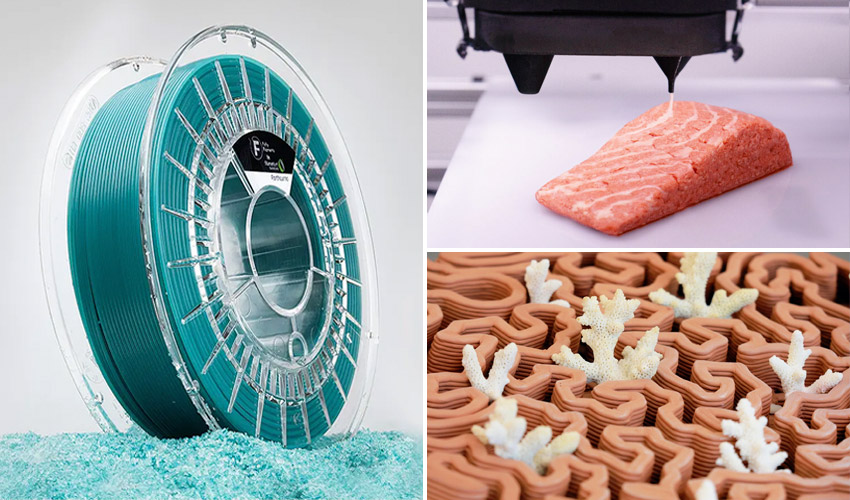
According to a study conducted by the European Parliament, between 4.8 and 12.7 million tonnes of plastic find their way into our oceans. This alarming statistic poses a significant threat to both our planet and the species inhabiting it. The Ellen Macarthur Foundation warns that by 2050, there could be more plastic in the oceans than fish.
In response to this pressing issue, numerous initiatives are emerging worldwide to safeguard our seas and oceans, with some leveraging 3D technologies. Indeed, 3D printing presents several advantages in waste recycling, such as repurposing fishing nets into printing materials and preserving marine biodiversity by creating artificial coral reefs. A multitude of projects employing additive manufacturing techniques are underway to protect our oceans, and today, we’ll explore a few of them.
Fish Alternatives
Revo Foods and Its 3D Printed Fish Substitutes
The demand for seafood products continues to drive the overexploitation and degradation of ecosystems worldwide. Overfishing, in particular, is depleting ocean wildlife at a rate faster than stocks can replenish. In response to this urgent global challenge, Revo Foods is proposing a solution in the form of plant-based, fish-substituted food produced using 3D printing technology. Recently, they have introduced a new 3D printing system, called Food Fabricator X2, which will allow them to take their production to an industrial scale. This new system highlights the high extrusion precision that gives a very real texture to the printed food, in addition to allowing the combination of different ingredients. In September of 2023, Revo Foods introduced their products to select supermarkets in Austria, where they were well-received by consumers.
Plant-based Fish Alternatives From Steakholder Foods
Steakholder Foods is now positioned as one of the leading companies specializing in the manufacture of meat and fish alternatives using 3D printing. Its aim is to offer sustainable, nutritious and delicious food solutions. When it comes to fish alternatives, the company currently offers the widest range of products on the market. Thanks to its exclusive 3D printing technology, Steakholder Foods has developed a plant-based white fish fillet, faithfully reproducing the appearance and texture of real fish. But that’s not all: the company has also announced the imminent arrival of new plant-based alternatives to eel, shrimp and salmon, all 3D printed. These products are mainly composed of water, plant proteins (soy, yeast), oils, natural flavors, vitamins and minerals.

“White fish” from Steakholder Foods (Photo Credits: Steakholder Foods)
Seawalls and Coral Reefs
D-Shape and the Hong Kong Bay Conservation Project
Italian firm D-Shape was honored with the 2022 Design for Asia Award for its custom reef design tailored for Hong Kong Bay. This initiative represents the latest step taken by the Hong Kong Airport Authority to safeguard the local marine environment. A total of one hundred artificial reef units were strategically positioned to foster the growth of a diverse community of organisms, including clams, sponges, and algae. Crafted in ring-shaped formations with holes of varying sizes, these reefs were created using 3D printing technology and a blend of quarry aggregate and cement binders. The reefs were then affixed to bamboo structures for stability underwater. As a result, the 3D printed artificial reefs are poised to provide a habitat for marine life and contribute to the restoration of the ecosystem.
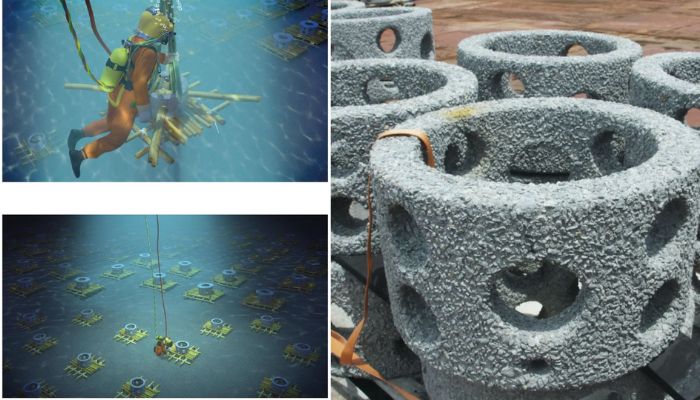
(Photo credit: DFA Design for Asia Awards/D-Shape)
3D Printed Living Seawalls by Kind Designs
Miami-based Kind Designs innovates by using 3D printing to design artificial seawalls and reefs. These structures function as effective bulwarks against coral reef degradation, flood risks and rising water levels. They also act as active marine ecosystems, promoting biological diversity and helping to restore marine habitats. By faithfully reproducing the structure of natural habitats, such as coral reefs and mangrove roots, these 3D printed seawalls provide refuge and food sources for numerous marine species, strengthening ecological resilience in the face of environmental challenges. Furthermore, their micro-design and texture are designed to encourage the adherence of corals and small organisms. Manufactured from a proprietary, metal- and chloride-free material mix, these structures do not introduce harmful chemicals into the ocean. Their materials have already proven their effectiveness in various artificial reef creation projects, as well as in the construction of drinking water reservoirs.
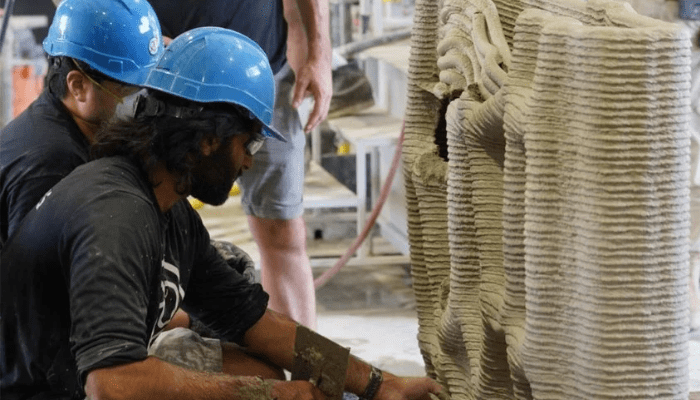
(Photo Credits: Kind Designs)
The Largest 3D Printed Coral Reef in the World
With 50% of reefs perishing over the last three decades, actions to counter threats like climate change, overfishing, and human-caused damage are imperative. Leveraging 3D printing technology, Australia’s Reef Design Lab has achieved a significant milestone by producing the world’s largest 3D printed artificial coral reef in the Maldives. This achievement involved creating intricate 3D molds mimicking natural reef structures, which were then cast in ceramic material akin to calcium carbonate found in actual reefs. These structures were submerged and populated with live coral, with the anticipation that they will foster new marine life and flourish as living reefs. This intersection of technology and conservation holds immense promise in safeguarding the oceans and nurturing marine biodiversity, as efforts continue to replenish these invaluable ecosystems for future generations.
Artec’s 3D Spider Scanner for Coral Reef Monitoring
The expanding applications of 3D printing now extend to coral reef monitoring for climate change effects and growth documentation. Traditionally, such studies imposed significant stress on corals, often leading to their demise. However, Dr. Jessica Reichert and her team from the University of Giessen have revolutionized this approach. Utilizing the Artec 3D Spider, a non-invasive handheld scanner, at the university’s Ocean2100 facility, they investigated the long-term impacts of global change stressors on various coral species. This scanner offers precise color data and can scan wet surfaces without harming corals, with customizable settings to optimize scan quality. With this method, Dr. Reichert can scan 50 to 100 corals daily with full safety assurance. The process involves placing the coral on a rotating plate under suitable lighting and scanning it from different angles. This innovative research paves the way for improved coral reef monitoring and protection.
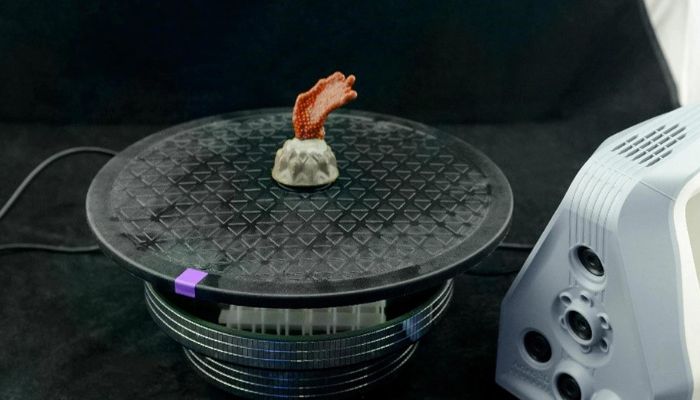
(Photo Credits: Dr. Jessica Reichert)
How SECORE Grows Corals
Boston Ceramics and Emerging Objects have joined forces with the conservation organization SECORE (Sexual Coral Reproduction) in a collaborative initiative that centers on understanding the reproductive behaviors of coral. SECORE gathers naturally released coral eggs and sperm, nurturing them in controlled environments until they transform into buoyant larvae. Subsequently, these larvae are placed within 3D-printed constructions designed to attract and facilitate coral attachment. Once firmly affixed, these structures are strategically positioned in reef zones for the purpose of restoration. Throughout this undertaking, the structures will be crafted using a ceramic material sourced from Boston Ceramics, and the 3D printing process will be facilitated by Emerging Objects.
WWF: 3D Printed Reefs For Cod and Oyster Stock Restoration
WWF is dedicated to upholding biodiversity through various initiatives. For instance, in 2018, a strategic partnership was established between the Danish energy company Ørsted and WWF Denmark, leading to the deployment of a 3D-printed coral reef in the North Sea’s Kattegat region, situated between Denmark and Sweden. The principal objective was to assess the contribution of 3D-printed structures to biodiversity. The depletion of cod populations was causing disruptions in the natural food chain, prompting the creation of the 3D-printed reef to facilitate the restoration of ecological equilibrium. In Denmark, this marked the inaugural project of its kind, although WWF already possessed prior experience with 3D-printed reefs. Similar endeavors had been initiated by WWF Netherlands in collaboration with Australian firm Reef Design Lab and Italian enterprise D-Shape. In the North Sea, 3D-printed reef units were positioned to rejuvenate oyster reefs. These units, created in Rotterdam, consist of 70% sand and 30% puzzolan cement. Approximately 50 reef units measuring 50×120 cm were deployed, and ongoing monitoring persists as research advances.
Recycled Ocean Waste
Fishy Filaments, Materials Made From Recycled Fishing Nets
Around 1-2% of monofilament nylon nets used in fishing end up lost in the oceans, creating an ongoing threat to marine life. Fishy Filaments is an organization equally committed to preserving our planet. Based in Cornwall, England, the company aims to reduce carbon emissions by combining recycling and additive manufacturing. In partnership with Fillamentum, it has developed an innovative method for transforming fishing nets recovered from the oceans and seas into filaments usable for 3D printing. These filaments and pellets, made from 100% recycled nylon 6 from used fishing nets, offer high-quality solutions suitable for a variety of technical and industrial applications. This process helps to reduce the environmental impact of plastic waste in the oceans.
LightArt’s 3D Printed Lighting Fixtures from Recycled Ocean Plastic
Since its founding in 2005, Seattle-based LightArt has specialized in crafting unique and innovative lighting fixtures using recycled materials through additive manufacturing. In 2023, the company began its collaboration with OceanWorks to utilize plastic waste collected from coastal areas, helping to mitigate the eight million tons of plastic entering the oceans annually. By breaking down and transforming these waste materials into a blend of pellets suitable for 3D printing, LightArt has produced several distinctive collections (most notably its Coil Collection), which include pendant lights made from 100% recycled polypropylene sourced from ocean debris. The result is lighting fixtures that embody a fusion of art and sustainability, with designs aesthetically inspired by ocean elements such as kelp and sea foam.
Parley – Leveraging Ocean Waste for 3D Printed Face Shields
Since 2012, the environmental organization Parley has tackled plastic pollution by working with industry leaders to develop 3D printing applications that utilize Parley Ocean Plastic, a material derived from intercepted ocean waste. Alongside its Parley AIR stations project, which enables coastal communities to 3D print furniture and other useful objects from collected waste, the organization has gained significant attention due to its efforts in combating COVID-19. At the height of the pandemic, Parley pivoted operations and partnered with Spanish startup Nagami to leverage 3D printing to produce essential protective gear. Utilizing recyclable ocean waste, the project produced more than 500 face shields daily (1 shield every 5 minutes), providing critical support for healthcare workers globally.
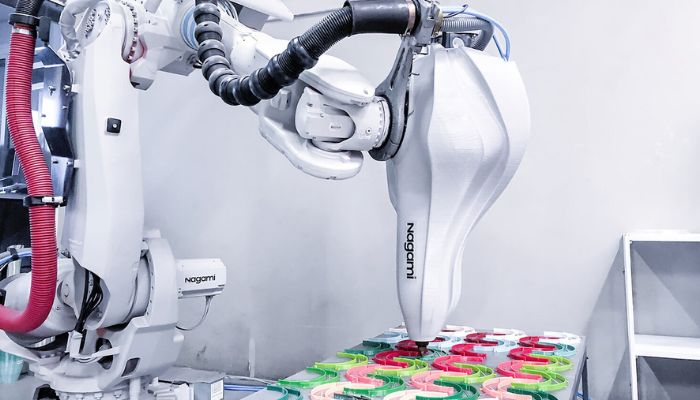
(Photo Credits: Parley for the Oceans)
What do you think of these projects to rebuild coral reefs using 3D printing? Let us know in a comment below or on our LinkedIn, Facebook, and Twitter pages! Don’t forget to sign up for our free weekly Newsletter here, the latest 3D printing news straight to your inbox! You can also find all our videos on our YouTube channel.






